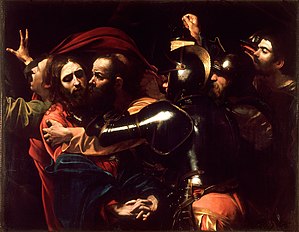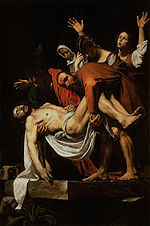Arrest of Jesus

canonical gospels |
 |
|
Portals: |
The arrest of Jesus was a pivotal event in
The arrest led immediately to his trial before the Sanhedrin, during which they condemned him to death and handed him to Pontius Pilate the following morning.[3] In Christian theology, the events from the Last Supper until the crucifixion and resurrection of Jesus are referred to as the Passion.
In the
Biblical narrative

| Part of a series on |
| Death and Resurrection of Jesus |
|---|
 |
|
Portals: |
According to the canonical gospels, after the Last Supper, Jesus and his disciples went out to Gethsemane, a garden located at the edge of the Kidron Valley, thought by scholars to probably have been an olive grove. Once there, he is described as leaving the group so that he can pray privately.[5][6]
The synoptics state that Jesus asked God for the burden of death by crucifixion to save humankind be taken from him, though still leaving the final choice to God. Luke states that an angel appeared and strengthened Jesus, who then accepted God's will and returned to his disciples. The synoptics state that the three disciples that were with Jesus had fallen asleep, and that Jesus criticized them for failing to stay awake even for an hour, suggesting that they pray so that they could avoid temptation.[6]
At that point,
The account in the Gospel of John differs from that of the synoptics: only in John do Roman soldiers help to carry out the arrest. Judas leads the arresting party to Jesus, but rather than Judas pointing out Jesus, John has Jesus himself, "knowing all that was to happen to him", ask them whom they are looking for; when they say "Jesus of Nazareth", he replies "I am he",[8] at which point all members of the arrest party went backward and fell to the ground.[6][7]
Only in the earliest version of Jesus's capture, appearing in the Gospel of Mark 14:51-52, is there any mention of a fleeing naked young man.
The arrest of Jesus and Judas' role in acting as a guide to those arresting him are subsequently referred to by Peter in Acts 1:16.
Gallery of art
-
Dieric Bouts, c. 1450-1460
-
The Taking of Christ by Gerard Douffet, c. 1620
See also
- Chronology of Jesus
- Life of Jesus in the New Testament
Notes
- ^ "Bible Gateway passage: Matthew 26:14-16 - New International Version". Bible Gateway.
- ^ "The death of Jesus", BBC
- ^ "Bible Gateway passage: Mark 15 - New International Version". Bible Gateway.
- ISBN 978-0-8010-2868-7
- ISBN 1-931018-31-6page 169
- ^ ISBN 978-0-88207-812-0pages 83-85
- ^ ISBN 0-7814-3868-3page 487-500
- ^ Note, the word "he" is supplied by the translators; the Greek has "I am", the Ego eimi, which explains why the arresting party is stunned. John 18:4
References
- Brown, Raymond E. An Introduction to the New Testament Doubleday 1997 ISBN 0-385-24767-2
- Brown, Raymond E. et al. The New Jerome Biblical Commentary Prentice Hall 1990 ISBN 0-13-614934-0
- Kilgallen, John J. A Brief Commentary on the Gospel of Mark Paulist Press 1989 ISBN 0-8091-3059-9
- Miller, Robert J. Editor The Complete Gospels Polebridge Press 1994 ISBN 0-06-065587-9



